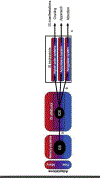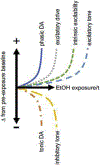Evidence for incentive salience sensitization as a pathway to alcohol use disorder
- PMID: 31672617
- PMCID: PMC6878895
- DOI: 10.1016/j.neubiorev.2019.10.009
Evidence for incentive salience sensitization as a pathway to alcohol use disorder
Abstract
The incentive salience sensitization (ISS) theory of addiction holds that addictive behavior stems from the ability of drugs to progressively sensitize the brain circuitry that mediates attribution of incentive salience (IS) to reward-predictive cues and its behavioral manifestations. In this article, we establish the plausibility of ISS as an etiological pathway to alcohol use disorder (AUD). We provide a comprehensive and critical review of evidence for: (1) the ability of alcohol to sensitize the brain circuitry of IS attribution and expression; and (2) attribution of IS to alcohol-predictive cues and its sensitization in humans and non-human animals. We point out gaps in the literature and how these might be addressed. We also highlight how individuals with different alcohol subjective response phenotypes may differ in susceptibility to ISS as a pathway to AUD. Finally, we discuss important implications of this neuropsychological mechanism in AUD for psychological and pharmacological interventions attempting to attenuate alcohol craving and cue reactivity.
Keywords: Alcohol sensitivity; Alcohol use disorder; Craving; Cue reactivity; Etiology; Incentive salience; Relapse; Sensitization; Treatment.
Copyright © 2019 Elsevier Ltd. All rights reserved.
Conflict of interest statement
Figures



Similar articles
-
Neural correlates of the addictions neuroclinical assessment (ANA) incentive salience factor among individuals with alcohol use disorder.Behav Brain Res. 2024 Apr 27;464:114926. doi: 10.1016/j.bbr.2024.114926. Epub 2024 Feb 29. Behav Brain Res. 2024. PMID: 38431152 Free PMC article.
-
Neural correlates of alcohol use disorder severity among nontreatment-seeking heavy drinkers: An examination of the incentive salience and negative emotionality domains of the alcohol and addiction research domain criteria.Alcohol Clin Exp Res. 2021 Jun;45(6):1200-1214. doi: 10.1111/acer.14614. Epub 2021 May 6. Alcohol Clin Exp Res. 2021. PMID: 33864389
-
Transfer of incentive salience from a first-order alcohol cue to a novel second-order alcohol cue among individuals at risk for alcohol use disorder: electrophysiological evidence.Addiction. 2021 Jul;116(7):1734-1746. doi: 10.1111/add.15380. Epub 2021 Jan 21. Addiction. 2021. PMID: 33338310 Free PMC article.
-
Individual differences in the attribution of incentive salience to reward-related cues: Implications for addiction.Neuropharmacology. 2009;56 Suppl 1(Suppl 1):139-48. doi: 10.1016/j.neuropharm.2008.06.027. Epub 2008 Jun 21. Neuropharmacology. 2009. PMID: 18619474 Free PMC article. Review.
-
Cued for risk: Evidence for an incentive sensitization framework to explain the interplay between stress and anxiety, substance abuse, and reward uncertainty in disordered gambling behavior.Cogn Affect Behav Neurosci. 2019 Jun;19(3):737-758. doi: 10.3758/s13415-018-00662-3. Cogn Affect Behav Neurosci. 2019. PMID: 30357661 Free PMC article. Review.
Cited by
-
Rescue of Comorbid Behavioral and Metabolic Phenotypes of Arrhythmic Mice by Restoring Circadian Cry1/2 Expression in the Suprachiasmatic Nucleus.Biol Psychiatry Glob Open Sci. 2023 Jul 1;3(4):632-641. doi: 10.1016/j.bpsgos.2023.06.002. eCollection 2023 Oct. Biol Psychiatry Glob Open Sci. 2023. PMID: 37881564 Free PMC article.
-
Preliminary evidence that individuals with remitted alcohol use disorder and major depressive disorder exhibit enhanced neural responses to reward: An EEG study.Addict Behav. 2023 Aug;143:107712. doi: 10.1016/j.addbeh.2023.107712. Epub 2023 Apr 2. Addict Behav. 2023. PMID: 37028135 Free PMC article.
-
Alcohol insensitivity and the incentive salience of alcohol: Two decades of work relevant to future directions of the addictions neuroclinical assessment.Transl Psychiatry. 2025 Feb 14;15(1):50. doi: 10.1038/s41398-025-03273-y. Transl Psychiatry. 2025. PMID: 39952968 Free PMC article. No abstract available.
-
Physical context of alcohol use and craving: An EMA exploratory study.Addict Behav. 2025 Aug 6;170:108450. doi: 10.1016/j.addbeh.2025.108450. Online ahead of print. Addict Behav. 2025. PMID: 40782603
-
Predictive utility of the P3 event-related potential (ERP) response to alcohol cues for ecologically assessed alcohol craving and use.Addict Biol. 2024 Feb;29(2):e13368. doi: 10.1111/adb.13368. Addict Biol. 2024. PMID: 38380714 Free PMC article.
References
-
- Acosta G, Hasenkamp W, Daunais JB, Friedman DP, Grant KA, Hemby SE, 2010. Ethanol self-administration modulation of NMDA receptor subunit and related synaptic protein mRNA expression in prefrontal cortical fields in cynomolgus monkeys. Brain Res 1318, 144–154. doi:10.1016/j.brainres.2009.12.050 - DOI - PMC - PubMed
Publication types
MeSH terms
Substances
Grants and funding
LinkOut - more resources
Full Text Sources
Other Literature Sources
Medical

